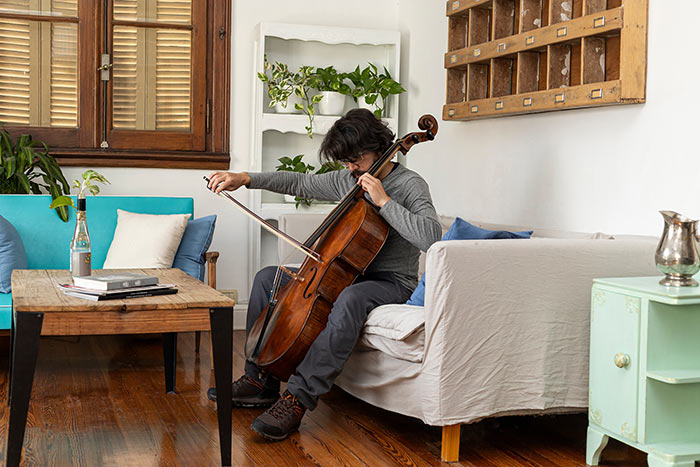The cello is a remarkable instrument that creates beautiful melodies. Before getting started with the cello, there are a few essential considerations to keep in mind. This guide is designed to help you prepare for your exploration into the world of cello playing, providing useful advice and insights along the way.
Let’s begin!
Choosing the Right Cello
Selecting the perfect cello is a big step in your music journey. It can really affect how much you enjoy playing and how well you improve as a cellist. Here’s a helpful guide to help you pick the right one:
Seek Expert Guidance: Start by consulting experienced professionals such as music store staff or cello teachers. They can offer valuable insights and assistance tailored to your needs and preferences.
Prioritise Sound and Playability: Focus on finding a cello with a pleasing sound and comfortable playability. Ensure it fits your body proportions properly to avoid discomfort during practice sessions.
Test Multiple Options: Take advantage of opportunities to test multiple cellos side by side. Evaluate factors such as tone quality, responsiveness, and craftsmanship to find the one that resonates with you.
Consider Your Budget: Factor in your budget and long-term goals when making your decision. There are cellos available at various price points, so choose one that aligns with your financial resources and aspirations.
Size Matters: Cellos come in various sizes, from 1/10 to full-size (4/4). Your height and the length of your arms should influence the size you choose for comfort and playability.
Rental vs. Purchase: For beginners, renting a cello is often recommended. This allows you to get a feel for the instrument without a significant upfront investment. As your commitment solidifies, consider purchasing a cello that meets your needs and preferences.
Quality and Setup: Look for a cello with good sound quality and a professional setup. The bridge, strings, and sound post significantly affect playability and sound. A well-set-up cello can make learning more accessible and more enjoyable.
Personal Journey: Ultimately, selecting the right cello is a personal journey. Invest time and effort into finding an instrument that resonates with you both sonically and ergonomically, ensuring a rewarding and fulfilling musical experience.
By following these refined guidelines and considering each aspect carefully, you’ll be well-equipped to choose the perfect cello for your musical journey.
Getting Help with Learning
Having guidance in your cello learning adventure can make a significant difference. Enrolling in lessons with a qualified teacher is highly recommended.
A teacher can offer personalised instruction tailored to your skill level and learning pace. They’ll teach you proper technique, help you develop good playing habits, and provide feedback to improve your skills.
You’ll gradually build your proficiency and confidence in playing the cello through regular lessons.
However, if taking lessons isn’t feasible for you, alternative resources are available to aid your learning journey.
Many instructional books and online videos provide valuable tutorials and exercises designed for beginners.
These resources cover a range of topics, from basic techniques to more advanced concepts, allowing you to progress at your own pace from the comfort of your home. While self-learning requires dedication and discipline, it can still be a rewarding experience, especially when supplemented with occasional feedback from experienced players or online communities.
Whether through formal lessons or self-study, having access to learning resources will undoubtedly enhance your cello-playing skills and enjoyment of music.
Basic Techniques
Learning how to play the cello starts with getting the basics right. These include things like how you sit, hold the bow, and use your fingers on the strings.
Let’s break down these essential techniques to help you get started on the right track.
Posture: Proper posture is vital in playing the cello. You should sit on the edge of your chair with both feet flat on the floor, holding the cello between your knees. The neck of the cello should rest slightly left of your head. This position helps reduce strain and enhance sound production.
Bow Hold: The bow hold, or grip, is fundamental in controlling the sound. Your thumb should be bent and placed on the frog (the end part of the bow), with your fingers relaxed and draped over the other side. A correct bow hold is crucial for producing a beautiful tone.
Finger Placement: Learning the positions and fingerings on the fingerboard is essential for playing notes accurately. Start with simple scales and exercises to build your finger strength and muscle memory.
Things You’ll Need
Before you start your journey of playing the cello, it’s essential to have all the necessary items to practise and perform effectively.
Here’s a list of essential equipment you’ll need:
Rosin: Rosin is a resin-like substance applied to the bow hair to enhance its grip on the strings. It’s vital for producing clear, resonant tones and preventing slipping while playing. Make sure to choose rosin that is compatible with your cello strings for optimal performance.
Tuner: Keeping your cello in tune is essential for producing harmonious melodies. A tuner helps you accurately tune each string to the correct pitch, ensuring your instrument sounds its best. Whether using a digital tuner or a tuning app on your smartphone, having this tool handy will make tuning your cello a breeze.
Music Stand: A music stand provides a stable platform to hold your sheet music or instructional materials while you practise. It helps you maintain proper posture and keeps your music within easy reach, allowing you to focus on playing without distractions.
Starting Books: Beginner-friendly instructional books are valuable resources for learning the fundamentals of cello playing. They provide structured lessons, exercises, and repertoire to guide you through the learning process and build your skills progressively.
Metronome: A metronome is a valuable tool for developing timing, rhythm, and consistency in your playing. It produces a steady beat at various tempos, helping you practise at the right pace and improve your sense of timing and musicality.
Replacement Strings: It’s essential to have spare cello strings on hand in case one breaks or wears out. Make sure to choose strings that are compatible with your cello, and consider keeping a set of different tensions to suit your playing preferences.
Cleaning Kit Specifically for Cellos: A cleaning kit designed for cellos includes specialised tools and products to keep your instrument clean and well-maintained. It typically includes items such as polish, fingerboard cleaner, and peg compound to ensure your cello stays in optimal condition.
Instrument Stand: An instrument stand provides a safe and convenient place to store your cello when not in use. It helps protect your instrument from damage and makes it easily accessible for impromptu practice sessions or performances.
The Power of Practise
Regular, focused practice is essential for improving cello skills. Begin with short sessions and gradually increase duration over time.
Incorporate scales, etudes, and easy songs to refine technique, intonation, and musical expression. Scales build fundamental skills, etudes offer targeted technical challenges, and easy songs provide context for applying techniques musically.
Approach practice with intentionality and mindfulness, focusing on quality over quantity. Break down challenging passages, employ deliberate practice techniques, and embrace a growth mindset to steadily progress.
Celebrate achievements along the journey and remain dedicated to improvement, and with consistent effort, you’ll continue evolving as a cellist, achieving new levels of proficiency and artistry.
Joining a Community
Engaging with a community of fellow cellists and musicians can significantly enrich your musical journey. Whether through participation in a local orchestra, ensemble, or cello group, these avenues offer invaluable opportunities for collaborative play, peer learning, and performance experience.
Additionally, online forums and social media groups serve as vibrant platforms for sharing experiences, seeking advice, and drawing inspiration from a diverse range of perspectives within the global musical community.
By actively connecting with others, you not only expand your network but also foster a supportive environment that encourages growth and camaraderie in your musical pursuits.
Conclusion
Starting to learn the cello is fun and fulfilling. With a good cello, help from a teacher or resources, and practise, you’ll soon be playing beautiful music.
It’s like stepping into a world of expressing yourself through music, and with the right instrument, a helpful teacher, and lots of practice, you’ll build a strong foundation for your musical journey.
Remember, getting good at the cello takes time and effort, so enjoy every lesson and challenge.
If you want expert help, think about joining our cello lessons at the London Cello Institute.
We’ll guide you every step of the way on your musical adventure!










